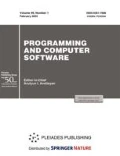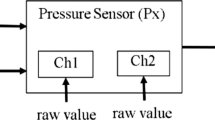Abstract
There is a gap between the formal modeling and testing methods for modern protocols and asynchronous software systems: due to high complexity of such systems, attempts to include formal models in testing procedures fail. In this paper, we propose an approach to filling this gap based on a formalization of the behavior of systems with asynchronous interfaces using contract specifications followed by the use of these specifications to design adaptive test suites. This approach was used for testing various software systems including implementations of the IPv6 Internet protocols stack and implementations of the POSIX and Linux Standard Base software interfaces.
Similar content being viewed by others
References
Hewitt, C., Viewing Control Structures As Patterns of Passing Messages, Artificial Intelligence, 1997, vol. 8, no. 3, pp. 323–364.
Goldberg, A. and Kay, A., Smalltalk-72 Instruction Manual, Xerox, 1976; http://www.bitsavers.org/pdf/xerox/alto/Smalltalk72_Manual.pdf.
CCIT Recommendation Z.100: Specification and Description Language (SDL), Geneva: ITU, 1993.
ISO/IEC 8807. Information Processing Systems—Open Systems Interconnection. LOTOS—A Formal Description Technique Based on the Temporal Ordering of Observational Behaviour, Geneva: ISO, 1989.
ISO/IEC 9646-3. Information Technology—Open Systems Interconnection—Conformance Testing Methodology and Framework—Part 3: The Tree and Tabular Combined Notation (TTCN), Geneva: ISO, 1992.
ISO/IEC 9646-3. Information Technology—Open Systems Interconnection—Conformance Testing Methodology and Framework—Part 3: The Tree and Tabular Combined Notation (TTCN), Geneva: ISO, 1998, 2nd Ed.
ETSI ES 201 873-1 V3.1.1. Methods for Testing and Specification (MTS). The Testing and Test Control Notation, Version 3. Part 1: TTCN-3 Core Language, Sophia-Antipolis, France: ETSI, 2005.
OMG Formal/05-07-07. UML Testing Profile, Version 1.0, Needham, USA: Open Management Group, 2005; http://www.omg.org//cgi-bin/doc?formal/05-07-07.
Ebrecht, L., Schacher, M., and Bühler, C., Test Specification in XML—The Most Important Element for Test FSM, ARTiSAN Benutzerforum D.A.CH, 2005.
A Unit Testing Framework for Java, http://www.junit.org.
A Unit Testing Framework for C, http://check.sourceforge.net.
A Unit Testing Framework for C++, http://cppunit.sourceforge.net.
TAHI: IPv6 Test Suite Development Project, http://www.tahi.org.
Meyer, B., Applying Design by Contract, IEEE Comput., 1992, vol. 25, no. 10, pp. 40–51.
Bourdonov, I.B., Kossatchev, A.S., Kuliamin, V.V., and Petrnko, A., UniTesk Test Suite Architecture, in Proc. of FME, Lect. Notes Comput. Sci., no. 2391, Springer, 2002, pp. 77–88.
IEEE 830-1998. Recommended Practice for Software Requirements Specifications, New York: IEEE, 1998.
IEEE 1233-1998. Guide for Developing System Requirements Specifications, New York: IEEE, 1998.
Introduction to IP Version 6, microsoft Corporation; http://www.microsoft.com/technet/itsolutions/network/ipv6/introipv6.mspx.
ISO/IEC 13818-11:2004. Information Technology—General Coding of Moving Pictures and Associated Audio Information—Part II: IPMP on MPEG-2 Systems, Geneva: ISO, 2003.
ISO/IEC 23360-1-8:2005. Linux Standard Base (LSB) Core Specification 3.1, Geneva: ISO, 2005.
Hoare, C.A.R., An Axiomatic Basis for Computer Programming, Commun. ACM, 1969, vol. 12, no. 10, pp. 576–585.
Guide to Software Engineering Body of Knowledge (SWEBOK), IEEE, 2005.
Kuliamin, V.V., Petrenko, A.K., Kossatchev, A.S., and Bourdonov, I.B., The UniTesK Approach to Designing Test Suites, Programmirovanie, 2003, no. 6, pp. 25–43 [Programming Comput. Software (Engl. Transl.), 2003, vol. 29, no. 6, pp. 310–322].
ANSI/IEEE 802.11. Information Technology—Telecommunications and Information Exchange between Systems—Local and Metropolitan Area Networks—Specific Requirements—Part 11: Wireless LAN Medium Access Control (MAC) and Physical Layer (PHY) Specification, New York: IEEE, 1999.
Narten, T., Nordmark, E., and Simpson, W., IETF RFC 2461. Neighbour Discovery for IP Version 6 (Pv6), 1998; http://www.ietf.org/rfc/rfc2461.txt.
Khoroshilov, A.V., Specification and Testing Systems with Asynchronous Interfaces, Preprint of the Inst. for System Programming, Russ. Acad. Sci., Moscow, 2006.
ISO/IEC 7498. Information Technology—Open Systems Interconnection—Basic Reference Model, Geneva: ISO, 1994.
McCloghrie, K. and Rose, M.T., IETF RFC 1213. Management Information Base for Network Management of TCP/IP-based Internets: MIB-II, 1991.
IETF RFC 2011. SNMPv2 Management Information Base for the Internet Protocol Using SMIv2, McCloghrie, K., Ed. 1996.
Haskin, D. and Onishi, S. IETF RFC 2465. Management Information Base for IP Version 6: Textual Conventions and General Group, 1998.
McCloghrie, K., Perkins, D., and Schoenwaelder, J., IETF RFC 2579. Textual Conventions for SMIv2, 1999.
Flick, J. and Johnson, J., IETF RFC 2665. Definitions of Managed Objects for the Ethernet-like Interface Types, 1999.
McCloghrie, K. and Kastenholz, F, IETF RFC 2863. The Interfaces Group MIB, 2000.
Flick, J., IETF RFC 3635. Definitions of Managed Objects for the Ethernet-like Interface Types, 2003.
IETF RFC 4293. Management Information Base for the Internet Protocol (IP), Routhier, S., Ed., 2006.
Keeni, G., Koide, K., Nagami, K., and Gundavelli, S., IRTF RFC 4295. Mobile IPv6 Management Information Base, 2006.
Grinevich, A., Kuliamin, V., Markovtsev, D., Petrenko, A., Rubanov, V., and Khoroshilov, A., The Use of Formal Methods for Controlling Programming Standards, in Trudy Instituta Sistemnogo Programmirovaniya, Ross. Akad. Nauk, Moscow: 2006.
ISO/IEC 9945-1:2003. Information Technology—Portable Operating System Interface (POSIX)—Part 1: Base Definitions, Geneva: ISO, 2003.
ISO/IEC 9945-2:2003. Information Technology—Portable Operating System Interface (POSIX)—Part 1: System Interfaces, Geneva: ISO, 2003.
ISO/IEC 9899-1999. Programming Languages—C, Geneva: ISO, 1999.
Author information
Authors and Affiliations
Corresponding author
Additional information
Original Russian Text © N.V. Pakulin, A.V. Khoroshilov, 2007, published in Programmirovanie, 2007, Vol. 33, No. 6.
Rights and permissions
About this article
Cite this article
Pakulin, N.V., Khoroshilov, A.V. Development of formal models and conformance testing for systems with asynchronous interfaces and telecommunications protocols. Program Comput Soft 33, 316–335 (2007). https://doi.org/10.1134/S0361768807060035
Received:
Issue Date:
DOI: https://doi.org/10.1134/S0361768807060035




